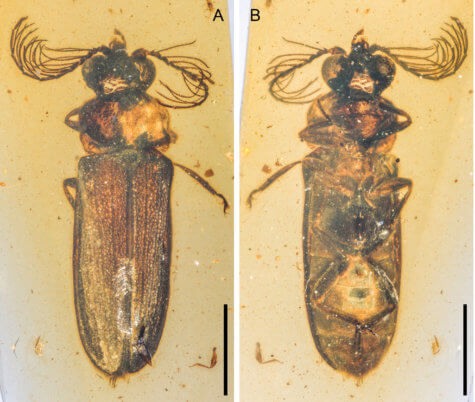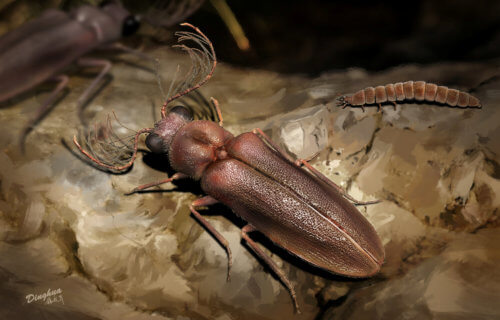BRISTOL, England — A 100-million-year-old beetle has been found frozen in time in transparent tree resin that provides an astonishing window into the distant past. Named Cretophengodes azaro, it lived in northern Myanmar during the age of the dinosaurs. It had big eyes and antennae, and was just over a quarter of an inch long.

“Most light-producing beetles are soft-bodied and quite small, and so have a sparse fossil record. However, this new fossil, found in amber from northern Myanmar, is exceptionally well-preserved, even the light organ on its abdomen is intact,” says co-author Professor Chenyang Cai of the University of Bristol, in a statement.
Its presence provides the earliest direct evidence that beetles were capable of producing light some 100 million years ago. In the insect world, light is used to detect prey, ward off predators, and attract members of the opposite sex. Some females even use it to lure unsuspecting males to eat.
With over 3,500 described species, light-producing beetles are the most diverse bioluminescent terrestrial animals. Historically, despite their diversity, the evolution of bioluminescence in beetles has been poorly understood. Scientists believe the discovery is the “missing link” in the evolution of fireflies.
“The newly discovered fossil, preserved with life-like fidelity in amber, represents an extinct relative of the fireflies and the living families Rhagophthalmidae and Phengodidae,” said co-author Dr. Yan-Da Li of Peking University, China. Most fall into the giant superfamily Elateroidea – with some 24,000 known species and thousands more awaiting to be described. Cretophengodes also sheds fresh light on how they should be classified.
“Elateroidea is one of the most heterogeneous groups of beetles and that has always been very difficult for entomologists to deal with, particularly because important anatomical innovations evolved, many times independently, in unrelated groups. The discovery of a new extinct elaterid beetle family is significant because it helps shed light on the evolution of these fascinating beetles,” says co-author Erik Tihelka, a student paleobiologist at Bristol.
At the time, the area was a balmy seaside forest. The trees bled massive quantities of resin when insects attacked them or storms broke off limbs. The resin puddled and pooled, entombing countless creatures. Amber excels at preserving fine detail – even cellular and sub-cellular material.
“We think light production initially evolved in the beetle’s soft and vulnerable larvae as a defensive mechanism to ward off predators. The fossil shows that, by the Cretaceous period, light production was taken up by the adults as well. It could have then been co-opted to serve other functions such as locating mates,” says co-author Dr. Robin Kundrata, a beetle expert at Palacky University in the Czech Republic.
Light producing beetles often have unusual adaptations. One of the most striking ones is that the females often don’t look anything like their male counterparts and instead retain many larval features into adulthood. “A good example of this is the trilobite beetle, where the females don’t look like beetles at all and instead superficially resemble trilobites. This means females often get overlooked when collecting in the field. We want to focus on these unusual beetles when searching the fossil record in the years to come,” says Dr. Li.
Cretophengodes is described in the prestigious British journal Proceedings of the Royal Society B.
